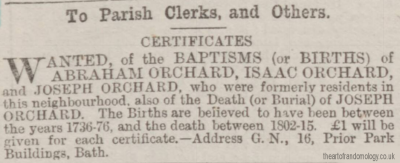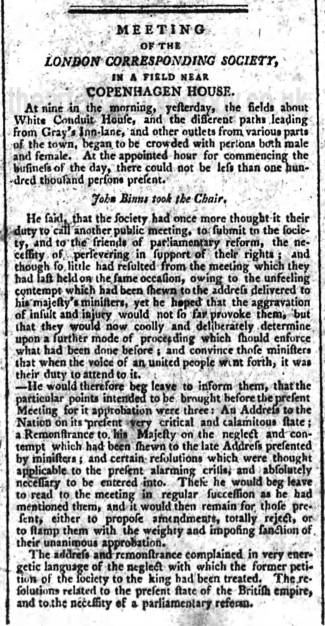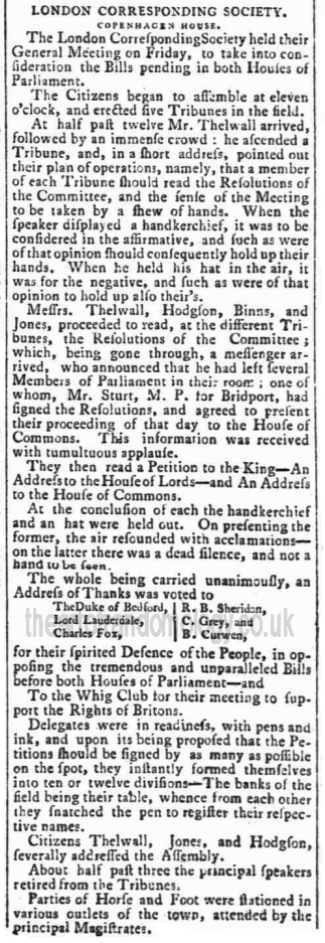Table of Contents
Intriguing. Too late to enquire? 
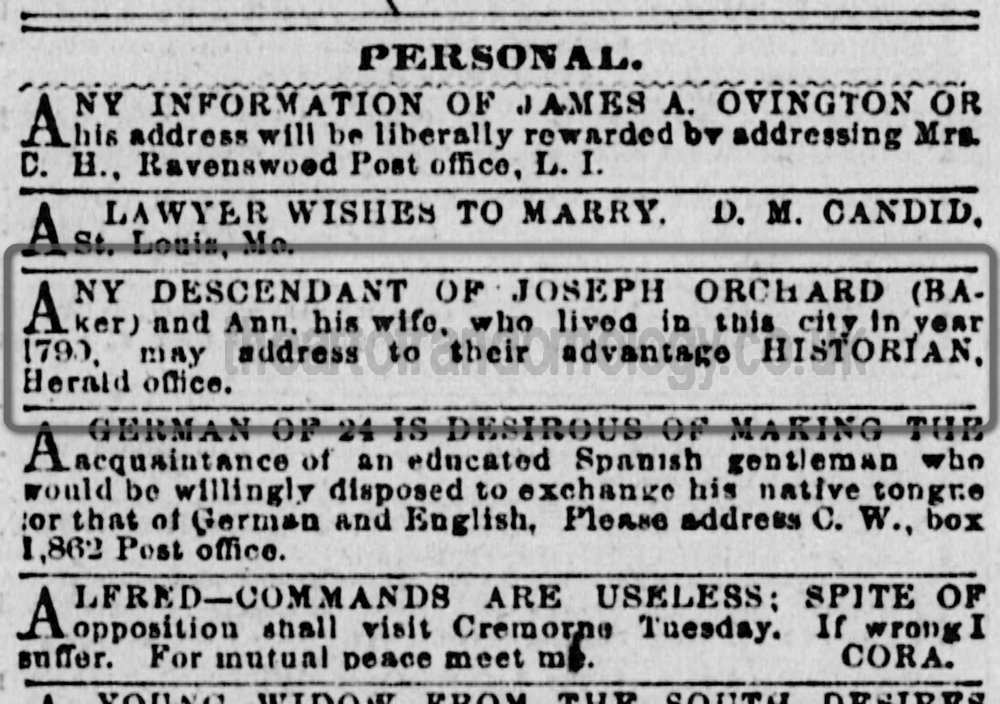
Joseph Orchard
1749-1805
(Jacob - Joseph - Tobyas - Tobias - Thomas)
View abridged page, also noting American Loyalist Claim, in downloadable PDF format.
Joseph ORCHARD was born 7 Jan 1749, Stokes Croft, Bristol, Gloucestershire, England.

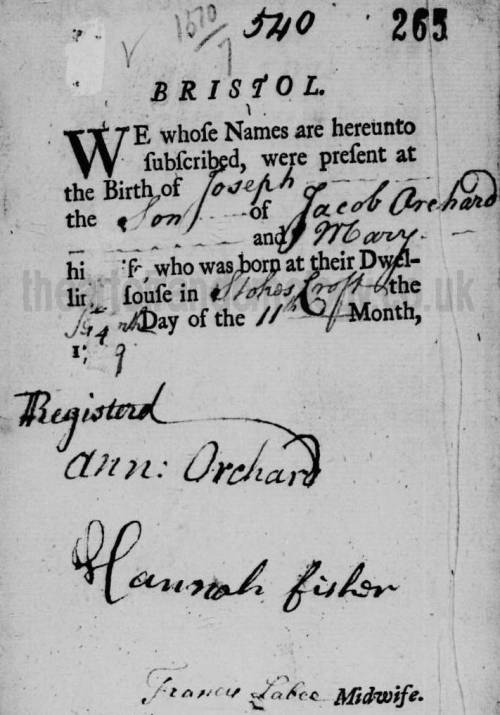
He was buried Bunhill Fields Burial Ground, London, 26 Dec 1805, aged 56.

Marriage & Children
He married Ann LANCASHIRE (Lankesheer), 25 Feb 1771, St James, Bath, Somerset, England.
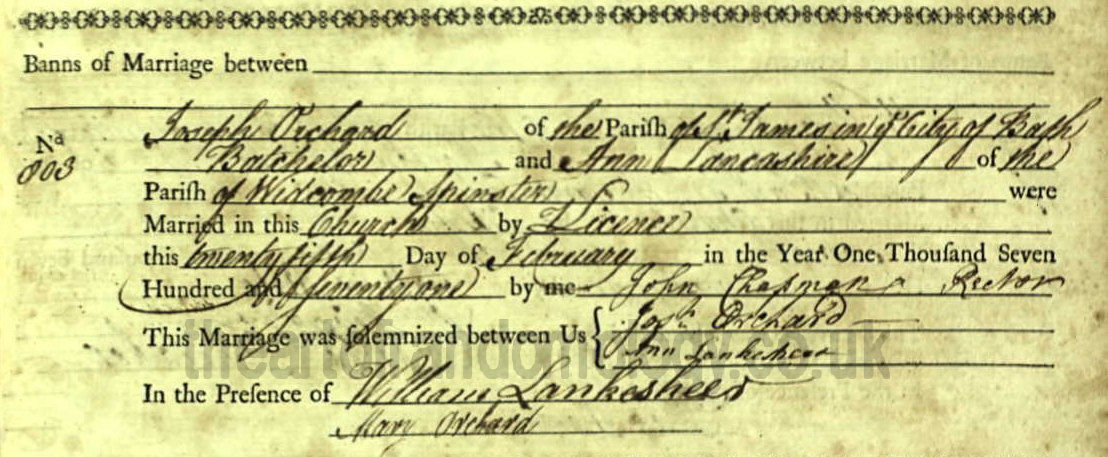
Children of Joseph Orchard and Ann:
- John ORCHARD, baptised 19 Jun 1772 - Widcombe, Bath, Somerset, England.
- Jacob ORCHARD, born c.1773 (may be John). Died 28 Jul 1789, Somerset, England.
- George Tryon ORCHARD, baptised 18 Feb 1780 - Trinity Church, New York City.
- Elizabeth ORCHARD, baptised 28 Nov 1781 - Trinity Church, New York City. »
- Ann ORCHARD.
- Plus at least 1 more
North America
In 1773, at the age of 24, he travelled to New York. He was appointed Superintendent of the King's Bakery in 1776 (“Recommended by Governor Tryon1) in consequence of Loyalty & services” - as a Loyalist, Joseph ran intelligence to the Governor on board the ship Duchess of Gordon2). See American Loyalist Claim for further details). In 1779 he settled in the Bloomingdale area, acquiring land previously owned by Oliver De Lancey (See The Oliver De Lancey Farm below).
“Also that he continued on the State of New York after the Evacuation came to England on February 1787, his Family is now at New York, and his Lands having proved that he purchased them before the Confiscation was decreed, are saved to him.”
“The Claimant continued at New York after Evacuation, in Possession of his Property there, and came to England in February 1787, where he has resided ever since.”

Documentation:
Inhabitants of New York, 1774-1776
- Thomas B. Wilson
Orchard, Joseph N[ew Yok] New York 75-T, 76-A
75-T: Rivington's New York Newspaper, Excerpts from a Loyalist Press 1773-1783, by Kenneth Scott.
76-A: Address to Admiral and General Howe, 16 October 1776. (New York City During the American Revolution, Mercantile Library Association of New York City, 1861, pp.117-137). A memorial to Admiral Lord Richard Howe and General Sir William Howe signed by 948 inhabitants of the City and County of New York expressing loyalty to King George the Third and praying that they, the Howe‘s, would restore this city to His Majesty‘s protection and peace.
American Migrations 1765-1799
- Peter Wilson Coldham
The lives, times and families of colonial Americans who remained loyal to the British Crown before, during and after the Revolutionary War, as related in their own words and through their correspondence.
Orchard, Joseph of NYC, baker. Memorial undated [1790]. For several years he was Superintendent of Bakers in NYC responsible for supplying bread to the Army: he made bread from rye, Indian corn, pease, and oatmeal, but from April 1779 to November 1781 he used his own flour. In July 1779 he bought from Brigadier-General DeLancey his farm at Bloomingdale*, intending to cut and sell the wood growing there, but was prevented by the Army from doing so, except for that required for his own family‘s use: soldiers were sent in to cut the remainder. He frequently took intelligence on board the Duchess of Gordon at great risk to himself. His wife and six children have been separated from him for three years and without help he cannot send for them to come to England. Claim for flour wood. Evidence: Letter 11 May 1789 Ightham, Kent, from John Milner to the Commission that he well knew the claimant from the time of his first arrival in America to the disgraceful loss of it, and was a near neighbour. Examination 1 May 1789 of John Barrow, formerly baker of NYC, re prices of flour there. (12/73/319; 13/7/384-425. 88/184-185, 94/378-381).
American Loyalist Claim
American Loyalist Claim For Joseph Orchard (images only).
I am (slowly) transcribing each page: here.
Pinpointing the Manhattan land and house
The Oliver De Lancey Farm - Bloomingdale*
*A reference noting the name “Little Bloomingdale” can be found in 2 West Side Rag online articles by Pam Tice of the Bloomingdale Neighborhood History Group, both of May 2021: Weekend History: 18th Century Bloomingdale Residents Before the American Revolution and Weekend History: The Revolutionary War in Bloomingdale
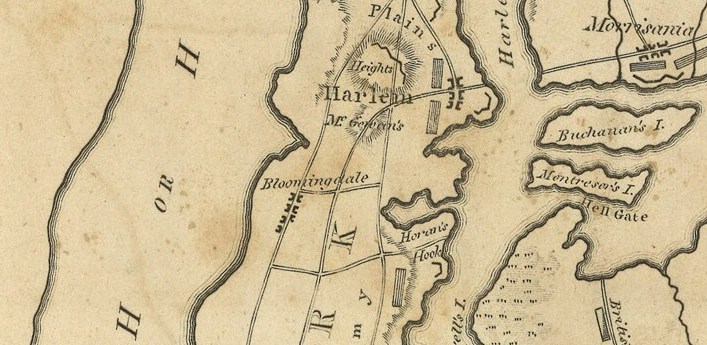
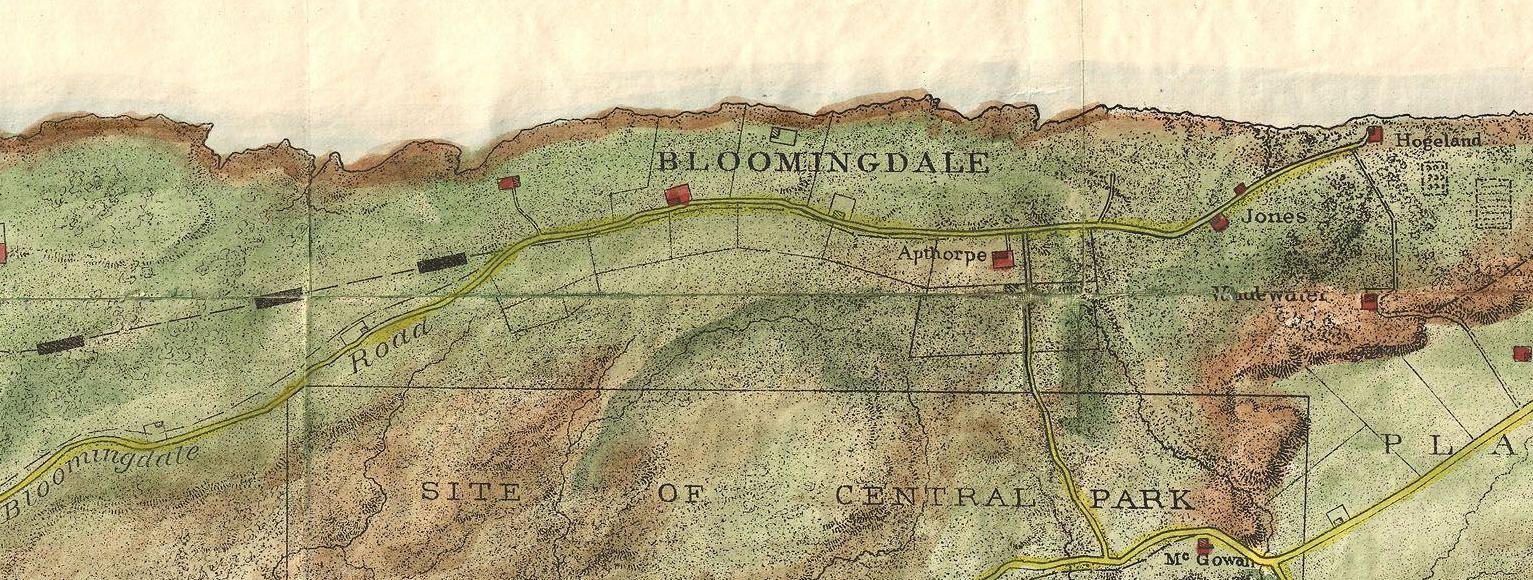
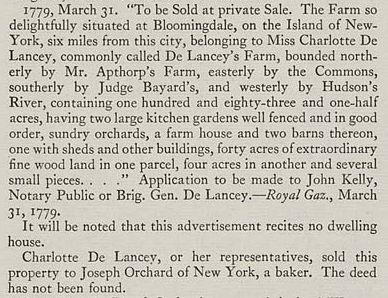 The country seat of Stephen De Lancey the elder, called Bloomingdale, became the Oliver De Lancey farm. It comprised lots 8,9, and 10 of the “Thousand acre tract”. No deeds to Stephen De Lancey have been found either recorded or unrecorded.
The country seat of Stephen De Lancey the elder, called Bloomingdale, became the Oliver De Lancey farm. It comprised lots 8,9, and 10 of the “Thousand acre tract”. No deeds to Stephen De Lancey have been found either recorded or unrecorded.
The four most northerly lots of the thousand acres belonged to Egbert Wouterse and Jan Vinge, but the allotments to these two patentees cannot be proved. From incomplete evidence, the theory has been deduced that lots 7 and 8 fell to Egbert Wouterse, lots 9 and 10 to Jan Vinge.
Lots 7 and 8 were probably sold to Thomas Hall. Hall was dead by Nov., 1669…
His widow made her will in August, 1669. In it she manumitted her slave and left him “aparcell of her lands layeing about the Great Kill”. This lot has been identified as lot 7 (see Teunis Somarindyke farm). In a deed of that lot, Brandt Schuyler is recited as the owner of lot 8. No other evidence of Schuyler's ownership has been found.
[ … ]
Oliver De Lancey built his own house near the river, at the upper end of his farm. He had probably finished it before he sold the old Stephen De Lancey house to Apthorp in 1763. This new house was attacked by a party of Continental soldiers on the night of Nov.26, 1777, plundered and set on fire…
The mansion seems to have been destroyed, but the farm buildings were left standing. The following advertisement proves that Oliver De Lancey had conveyed the farm to his daughter, no doubt to avoid its confiscation.
1779, March 31.“To be Sold at private Sale. The Farm so delightfully situated at Bloomingdale, on the Island of New-York, six miles from this city, belonging to Miss Charlotte De Lancey, commonly called De Lancey's Farm, bounded northerly by Mr. Apthorp's Farm, easterly by the Commons, southerly by Judge Bayard's, and westerly by Hudson's River, containing one hundred and eighty-three and one-half acres, having two large kitchen gardens well fenced and in good order, sundry orchards, a farm house and two barns thereon, one with sheds and other buildings, forty acres of extraordinary fine wood land on one parcel, four acres in another and several small pieces…” Applications to be made to John Kelly, Notary Public or Brig. Gen. De Lancey. - Royal Gaz., March 31, 1779.
It will be noted that this advertisement recites no dwelling house.
Charlotte De Lancey, or her representatives, sold this property to Joseph Orchard of New York, a baker. The deed has not been found.
Sept. 11. 1781. Joseph Orchard mortgaged the land “Known as the De Lancey Farm,” about 183 acres, to Daniel Cock and Daniel Underhill, both of the Township of Oyster Bay, farmers, for 2500 Spanish Milled dollars. - Lier Deeds, XLI: 73 (New York). The mortgage did not recite a dwelling house: merely “buildings, offices, gardens,” etc.
The old Bloomingdale Road, which was at this point ran east of the later road, as shown on the map, divided Joseph Orchard‘s land into two farms. He conveyed the 40 acre farm west of the old road to John Lovell, April 12, 1785 “With the dwelling house, Buildings, offices, and gardens.” - Ibid., XLII: 360.
These recitals prove that on this 40 acres between the road and the river, Orchard had a dwelling house, before 1785, although there was none there in 1781.
A comparison of the advertisement with the Randel Map shows that the physical situation had changed very little in thirty years. Orchards had evidently rebuilt on the site of the mansion destroyed in 1777. The new house, a large one with a hipped roof, stood on a knoll about 400 feet from the river, a long distance back from the road. To the north of the house, a farm house and other buildings, accurately described in the advertisement on 1779. A dock is shown on the Randel Map. Perhaps it was the landing place of the troops on that November night in 1777.
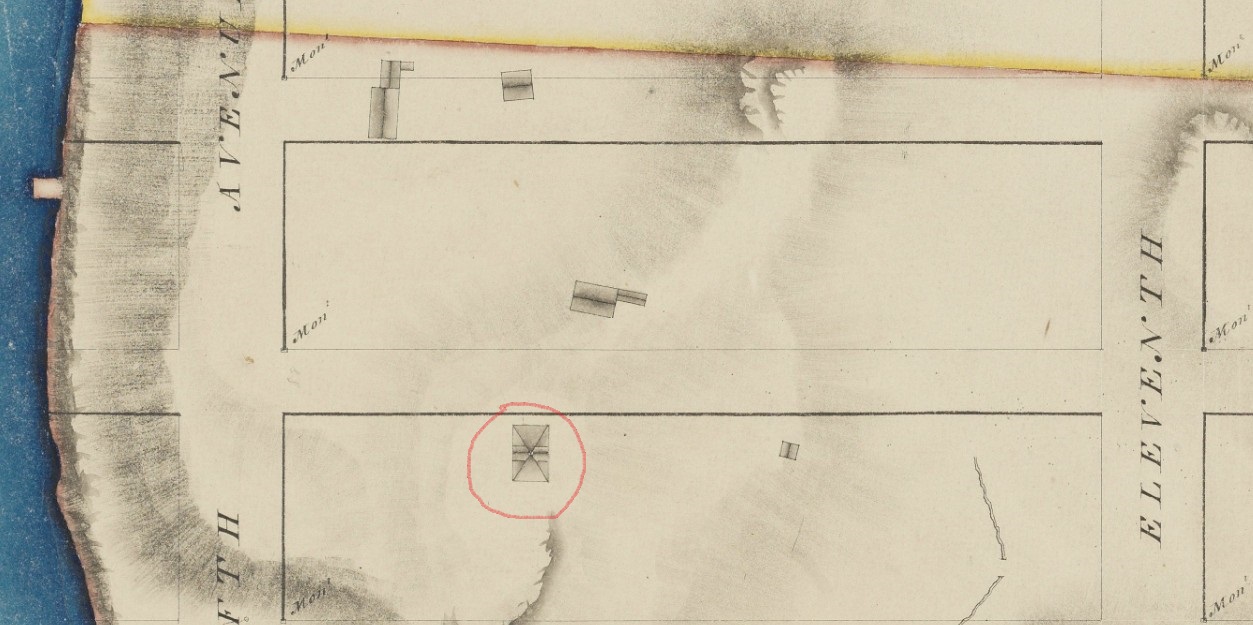
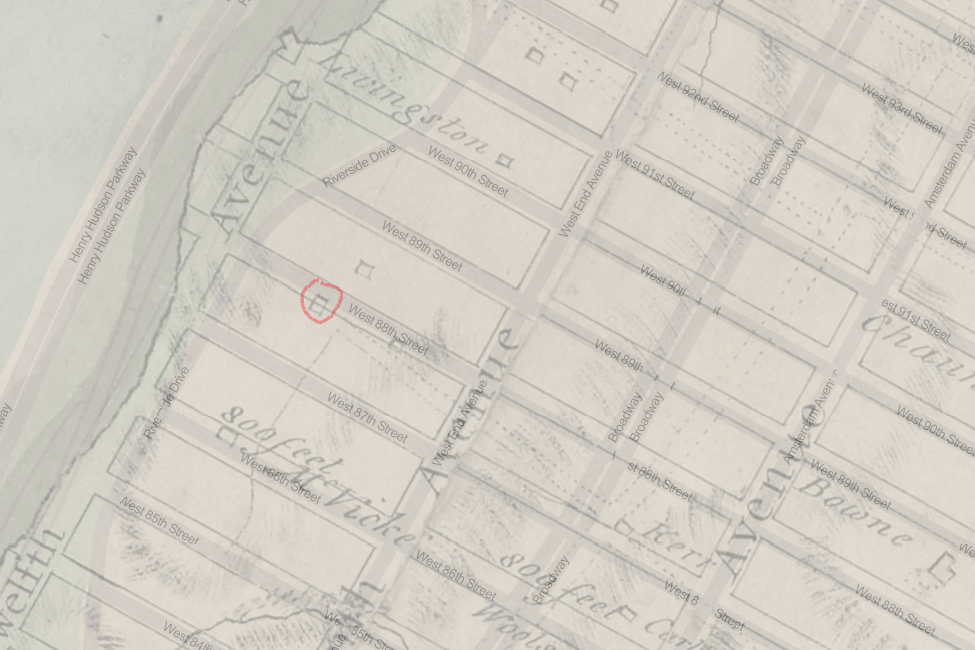
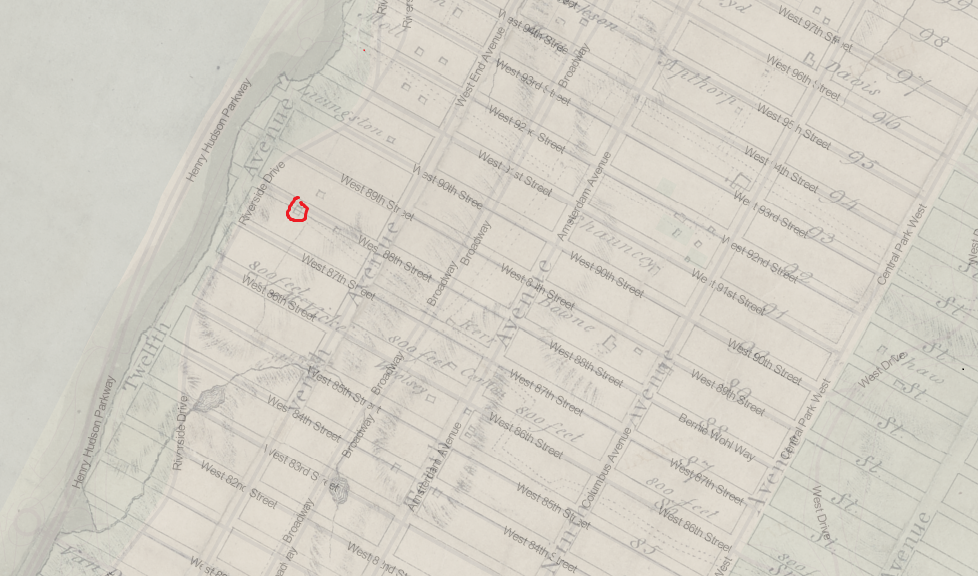
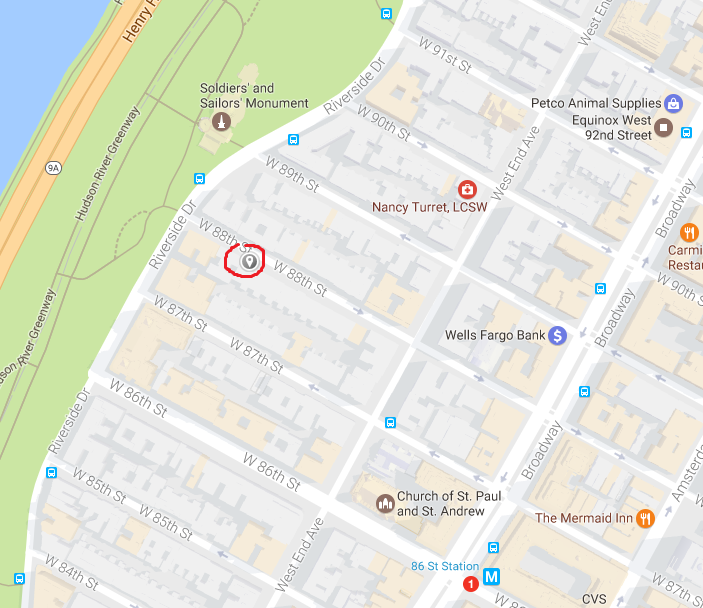
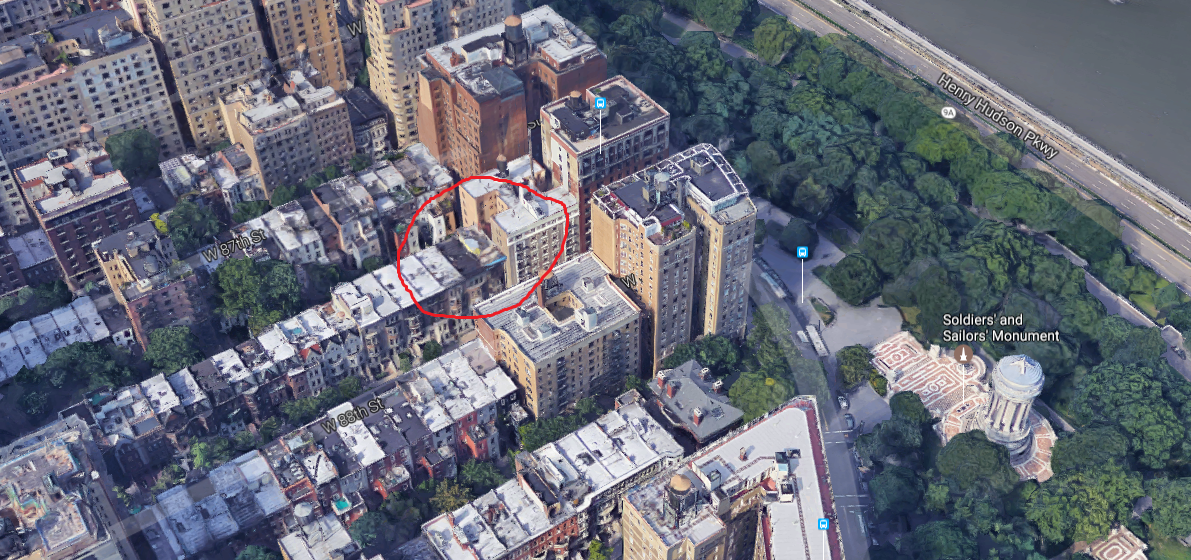
On the present city plan, the house would be south of 88th St., about 100 feet east of Riverside Drive; the farm house in the block above; the barn, “with sheds and other buildings,” in the bed of Riverside Drive at 89th St.; the other barn 100 feet to the east, partly in the bed of 89th St.
[ … ]
In a deed dated March 28, 1806, Rebecca Apthorp conveys to David Wagstaff “… a tract of land bounded east by the Commons of the city of New York; south by the land of Somarindyck; west by land of Philip Kissick, and north by land of Joseph Orchard. 39 acres; 3 rods; 12 perches.”
From: Stokes, I. N. Phelps The iconography of Manhattan Island, 1498-1909 - Pages 94-96
Full book available in PDF archive.org
Note:
It has been quite hard tracking down exact details, as most accounts jump from De Lancey straight to Henry Brockholst Livingston - the latter having build his property on the corner of W.90th and Riverside. Yet, as can be seen by the above maps, the Orchard property was probably located on the south-side of W.88th.
Maps used:
1 1776
2 Johnston
3 & 4 gigapan.com
5 Interactive 1811 Plan
6 Google Maps
England
Upon returning to England, Joseph is next recorded as being the Victualler of Copenhagen House, Islington, Middlesex.
In 1798 he declares bankruptcy3).

In 1801, after what appears to be a refurbishment, he “…most respectfully solicits the continuance of his Friends and the Public, at the approaching Season for rural Recreations.”
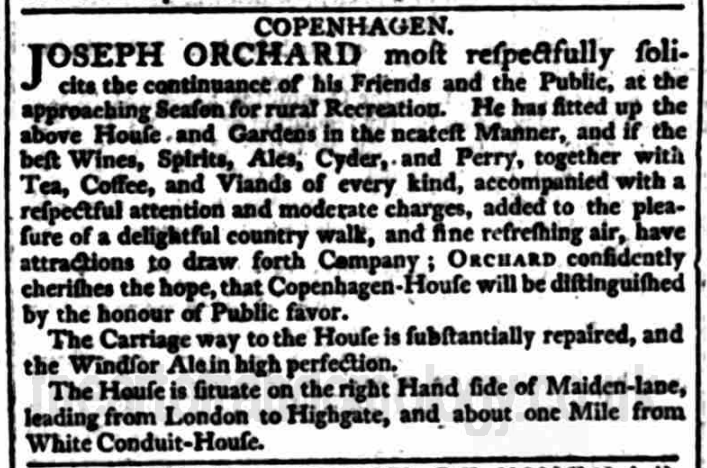
Historical Notes:
Both Copenhagen House and Copenhagen Fields were frequently used for political meetings.
The History and Topography of the Parish of Saint Mary, Islington,
in the county of Middlesex, 1842, pp.284-285
In the early part of the French revolution, when the premises were kept by Orchard, the neighbouring fields became the scene of various public MEETINGS, convened by the “London Corresponding Society,” and which created much alarm. The most remarkable of these was one held on the 26th of October, 1795, when not less than 40,000 persons were collected, and harangued by different orators, who threw out invitations to the multitude to attend to the circumstance of the king's going to the house on the 28th. Accordingly, on that day an immense crowd assembled in the park, with the most desperate designs of mischief; but the king, although he was shot at, and otherwise incurred great risk, fortunately escaped unhurt.
[Orchard is my emphasis. Full book available to read via Google Books.]
Islington Gazette - Monday 30 November 1908, p.3
The Metropolitan Cattle Market, Islington, popularly known as “the Cattle Market”… opened in 1855… has no striking history of its own, it is interesting as being built on the site of Copenhagen House, a famous tavern, with tea-gardens attached, and Copenhagen Fields…
Both house and fields were frequently used for political meetings, and one of Gillray's best caricatures represents the great meeting at Copenhagen House, on November 13th, 1795, called by the London Corresponding Society, to petition Parliament against the “Bill for the Protection of the King's Person,” introduced in consequence if the “Bread Riots.”
A meeting called by the London Corresponding Society, 1795.
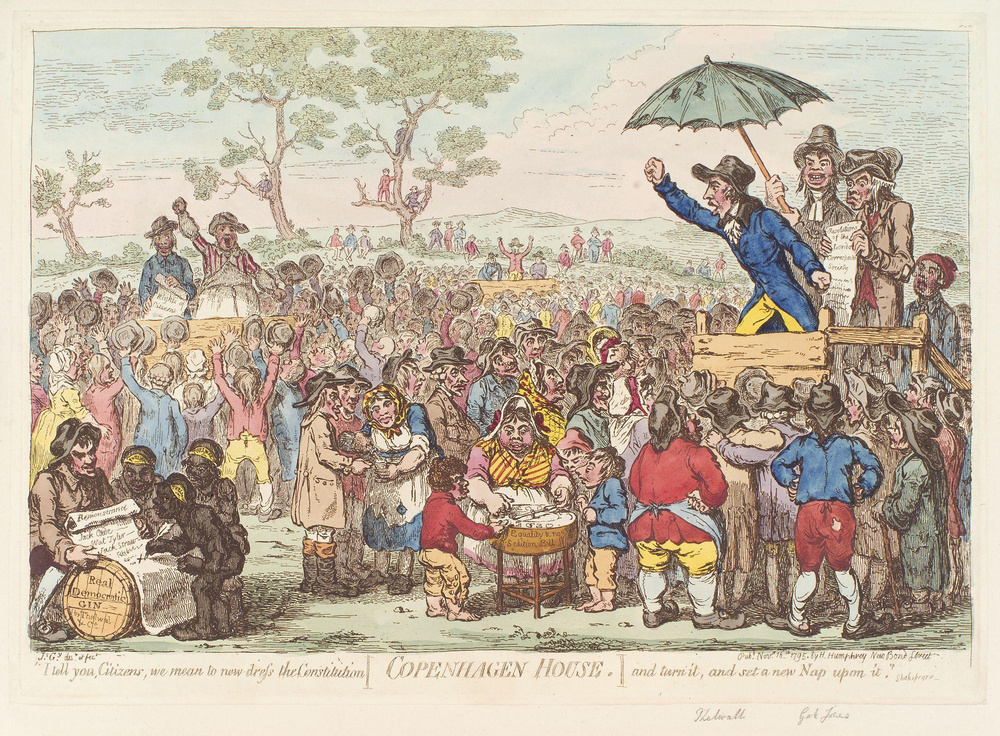
A Big Thank You
11 Dec 2016
Through the sad passing of a 16 year old lad in 1789, I have been able to break through one of my toughest brick walls - in that, a request to Thomas Durnell, Grave-Maker of Bath, asks for a grave to be made for Jacob Orchard, son of Joseph Orchard of New York in America.
That I was even looking in the county of Somerset, I thank Prevaricat creator of The Ridouts of Sherborne and Bath website that turned up through an online search: and to which we now have what may be several more pieces of the puzzle we have both been seeking.

